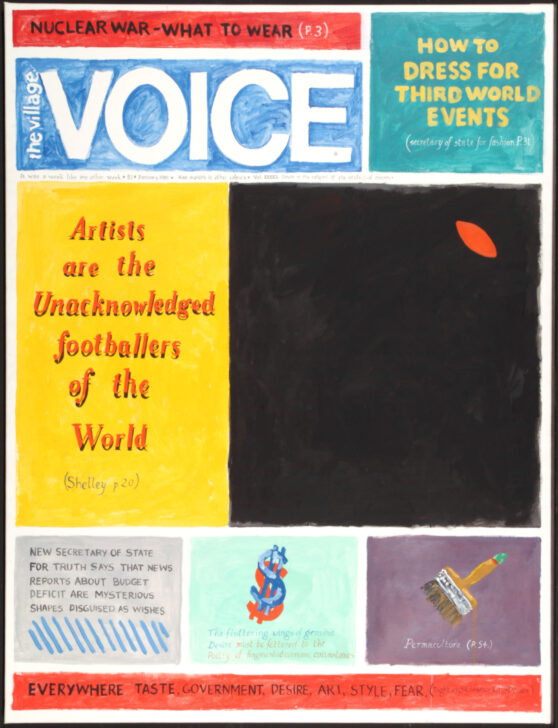The Village Voice
Jacob Atkinson; Conrad Atkinson

Description
Since the early 1970s Conrad Atkinson has used his work to highlight political and social injustices and the absurdities of life in a media saturated environment. Raised in a coal-mining village in the north of England and strongly aligned with the British labor movement, Atkinson has often resisted being labeled an “artist.” Insisting that art is inextricably linked to both politics and economics, Atkinson prefers the term “cultural producer” to describe his practice.
The Village Voice is one of a series of paintings in which Atkinson appropriates the front page formats of well-known newspapers in order to deliver darkly humorous commentaries on topics ranging from political double-speak and the threat of nuclear war to the position of the artist in contemporary society. In mimicking the format of the newspaper, Atkinson seeks less to replicate the paper’s appearance than to mobilize it as a means to question how we receive and process different kinds of cultural information: “The thing I try to do,” he has said, “is to render visible the invisible things that control the way we see things.”
Jacob Proctor, Associate Curator of Modern & Contemporary Art
--------------------------------------------------
6/28/10
Conrad Atkinson (England, born 1940)
The Village Voice
1988
Acrylic on canvas
Gift of Jack A. and Noreen Rounick
Since the early 1970s Conrad Atkinson has used his work to highlight political and social injustices and the absurdities of life in a media saturated environment. Raised in a coal-mining village in the north of England and strongly aligned with the British labor movement, Atkinson has often resisted being labeled an “artist.” Insisting that art is inextricably linked to both politics and economics, Atkinson prefers the term “cultural producer” to describe his practice.
The Village Voice is one of a series of paintings in which Atkinson appropriates the front page formats of well-known newspapers in order to deliver darkly humorous commentaries on topics ranging from political double-speak and the threat of nuclear war to the position of the artist in contemporary society. In mimicking the format of the newspaper, Atkinson seeks less to replicate the paper’s appearance than to mobilize it as a means to question how we receive and process different kinds of cultural information: “The thing I try to do,” he has said, “is to render visible the invisible things that control the way we see things.”
Subject Matter:
One of a series of paintings in which Atkinson appropriates the front page formats of well-known newspapers in order to deliver darkly humorous commentaries on topics ranging from political double-speak and the threat of nuclear war to the position of the artist in contemporary society.
Physical Description:
The cover format of the New York weekly newspaper The Village Voice is appropriated, with satirical headlines related to topical current events.
Usage Rights:
If you are interested in using an image for a publication, please visit https://umma.umich.edu/request-image/ for more information and to fill out the online Image Rights and Reproductions Request Form.